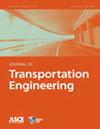混合车辆技术环境下不同高速公路合流策略的预期安全性能
Q Engineering
引用次数: 0
摘要
本研究评估了不同的合并解决方案,这些解决方案可以减少混合交通环境中合并车辆与干线交通之间的冲突,使用安全措施来查看在特定交通条件下哪种策略可能比其他策略更好。混合交通包括不同比例的无人驾驶汽车(DVs)和联网自动驾驶汽车(cav)。选择不符合概率(PNC)作为替代安全度量来评估策略。开发了MATLAB程序,模拟了合流区域的各种交通状况,并计算了不同合流策略下的PNC合流。此外,为了检验PNC与合并区域碰撞频率之间的关系,我们收集了渥太华15个合并坡道的碰撞数据,以检验在全dv车队无管理策略(当前条件)的情况下,仿真得到的PNC值与实际安全性能之间的关系。结果证实了PNC作为一种替代安全措施的有效性,该措施与合并区域的预期碰撞频率相关。通过模拟所有提出的合并管理策略,本研究的结果显示,即使在不使用管理策略或不采取任何措施的情况下,由于CAV渗透率增加,PNC总体呈下降趋势,因此安全性能得到改善。然而,大多数合并策略的预期安全性能都优于不采取行动的选择,这表明了实施合并管理策略的价值,特别是在从全dv到全cav的过渡时期。本文章由计算机程序翻译,如有差异,请以英文原文为准。
Expected Safety Performance of Different Freeway Merging Strategies in an Environment of Mixed Vehicle Technologies
This study evaluates different proposed merging solutions that reduce the conflict between merging vehicles and mainline traffic within a mixed traffic environment using a safety measure to see which strategy might work better than others under specific traffic conditions. The mixed traffic includes various percentages of driver-operated vehicles (DVs) and connected autonomous vehicles (CAVs). The probability of noncompliance (PNC) is selected as a surrogate safety measure to assess the strategies. A MATLAB program is developed to simulate various traffic conditions at a merging area and to calculate the PNC merging for the different merging strategies. In addition, to examine the relationship between PNC and collision frequency at the merging area, the collision data at 15 merging ramps in Ottawa were collected to examine the relationship between PNC values obtained from the simulation for the case of a full-DV vehicle fleet and no management strategy (current conditions) and actual safety performance. The results confirmed the validity of PNC as a surrogate safety measure that is correlated to expected collision frequency at merge areas. By simulating all proposed merging management strategies, the results of this study showed a general trend of decreasing PNC and, hence, improved safety performance since the CAV penetration rate increases even when no management strategy is used or under the do-nothing option. However, most merging strategies had better expected safety performance than the do-nothing option, which indicates the value of implementing a merging management strategy, especially during the period of transition from a full-DV to a full-CAV fleet.
求助全文
通过发布文献求助,成功后即可免费获取论文全文。
去求助
来源期刊

Journal of Transportation Engineering
工程技术-工程:土木
CiteScore
1.22
自引率
0.00%
发文量
0
审稿时长
3.6 months
期刊介绍:
Information not localized
 求助内容:
求助内容: 应助结果提醒方式:
应助结果提醒方式:


